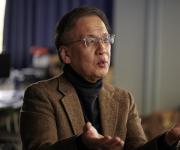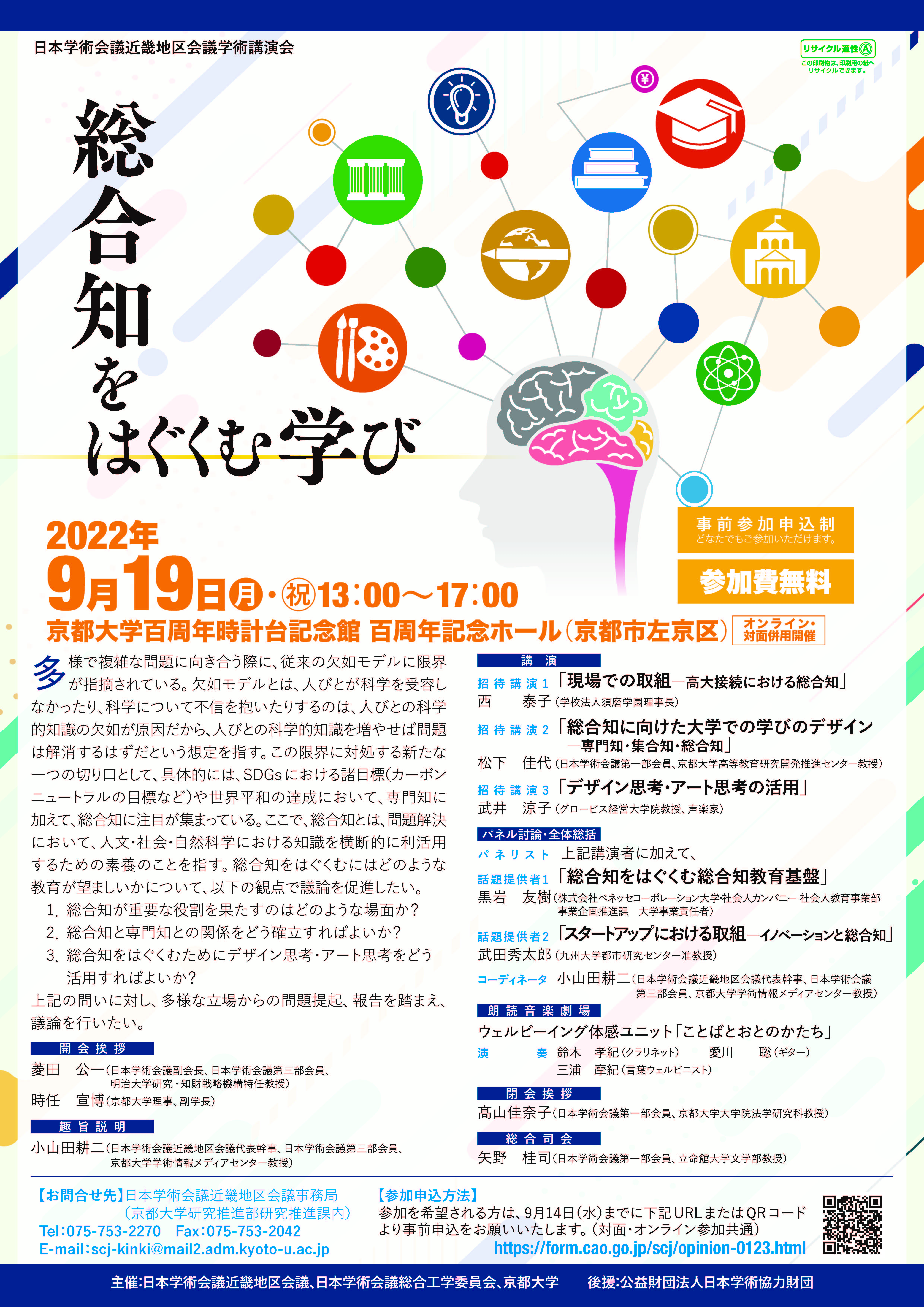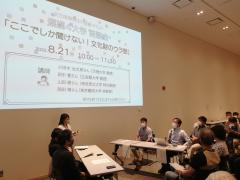-
 12
13
14
15
16
17
18
19
20
21
22
12
13
14
15
16
17
18
19
20
21
22
 [イベント情報]November 10, 2022(Thu)
[イベント情報]November 10, 2022(Thu)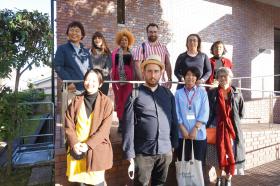 On November 4, 2022, the Art Research Center (ARC) welcomed the research project team of J-InnovaTech--led by Prof. Aleksandra Kobiljski--to an international workshop hosted by the FY 2022 ARC-iJAC international joint research project 'A Digital Archive Connecting Modern Design and Industry: Towards a New History of Machine Textile Printing in Modern Kyoto' (project leader: Aya Ueda).
On November 4, 2022, the Art Research Center (ARC) welcomed the research project team of J-InnovaTech--led by Prof. Aleksandra Kobiljski--to an international workshop hosted by the FY 2022 ARC-iJAC international joint research project 'A Digital Archive Connecting Modern Design and Industry: Towards a New History of Machine Textile Printing in Modern Kyoto' (project leader: Aya Ueda).Prof. Kobiljski is a researcher affiliated with the French National Centre for Scientific Research (CNRS) and director of the Centre de recherches sur le Japon at the École des hautes études en sciences sociales (EHESS) as well as deputy director of the UMR Chine-Corée-Japon (CCJ-EHESS).
Currently, she is conducting the J-InnovaTech project 'Beyond Eureka: The Foundations of Japan's Industrialization, 1800-1885', which was awarded a European Research Council (ERC) Starting Grant in 2018.
The international workshop was chaired by Prof. Keiko Suzuki, Deputy Director of the Art Research Center (ARC). During the workshop, researchers from both sides exchanged opinions on the history of the textile industry in Kyoto in the 19th century and discussed future research cooperation.
Event information
Date: November 4 (Fri), 15:20-19:00
Place: Soshikan SO405, Kinugasa Campus, Ritsumeikan University, Kyoto
Organizer: International joint research project 'A Digital Archive Connecting Modern Design and Industry: Towards a New History of Machine Textile Printing in Modern Kyoto' (「新しい近代京都機械捺染史構築に向けて―近代デザインと産業史をむすぶデジタル・アーカイブを一助として―」), adopted by the International Joint Digital Archiving Center for Japanese Art and Culture (ARC-iJAC)/ Project leader: Aya Ueda (Part-time Lecturer, Kwansei Gakuin University and Doshisha Women's College of Liberal Arts)
Co-organizer: International Joint Digital Archiving Center for Japanese Art and Culture (ARC-iJAC), Art Research Center, Ritsumeikan University
Please note that this was a non-public event.
 With the establishment of the International Joint Digital Archiving Center for Japanese Art and Culture (ARC-iJAC) in 2019, the Art Research Center strives to push the internationalization of research activities that transcend disciplines and geographic boundaries.
With the establishment of the International Joint Digital Archiving Center for Japanese Art and Culture (ARC-iJAC) in 2019, the Art Research Center strives to push the internationalization of research activities that transcend disciplines and geographic boundaries.NEWS
 The ARC received the Digital Archive Japan Award (DAJ) 2022 on Aug.25
The ARC received the Digital Archive Japan Award (DAJ) 2022 on Aug.25
The ARC is enormously honored to be one of the first recipients of the Digital Archive Japan Award (DAJ).
The DAJ is an award system newly established by Japan Search, a platform operated by the National Diet Library, for aggregating metadata of digital resources. Regarding this award, Prof. Ryo Akama, Director of the ARC, expressed:
Regarding this award, Prof. Ryo Akama, Director of the ARC, expressed:
"The ARC faculty would like to take this award as an opportunity to further respond to the needs of users worldwide by disseminating information on cultural resources in Japan which go beyond areas such as ukiyo-e, early Japanese books, and banzuke-related contents."
As a curator at the Prince Chichibu Memorial Sports Museum, Murakami is leading a joint research project with the ARC on digital-archiving the extensive collection of sports materials of the museum in cooperation with the ARC. 
She also reflects on her internship experience at UC Berkeley, facilitated by the ARC, while she was a graduate student at Ritsumeikan University. >>Read full interview. 
Prof. Hosoi took on a pioneering role when he founded the Game Archive Project (GAP)--a collaboration between Nintendo, Kyoto Prefecture, and Ritsumeikan University. 
In the interview, Prof. Hosoi reflects on the early days of his game research and discusses the social impact of games, the acceleration of the metaverse amid COVID-19, and future directions for game research. 
 On August 21, 2022, ARC faculty member Prof. Satoshi Tanaka (College of Information Science and Engineering, RU) presented the research outcomes of his project on the ultra-high-quality see-through 3D visualization of Taimadera Temple at a roundtable event, held as part of its special exhibition 'Researching Cultural Heritages' at the Nara Prefecture Historical and Artistic Culture Complex. >>Read more.
On August 21, 2022, ARC faculty member Prof. Satoshi Tanaka (College of Information Science and Engineering, RU) presented the research outcomes of his project on the ultra-high-quality see-through 3D visualization of Taimadera Temple at a roundtable event, held as part of its special exhibition 'Researching Cultural Heritages' at the Nara Prefecture Historical and Artistic Culture Complex. >>Read more.
Mikiharu Takeuchi took home top honors at the award ceremony for the 11th Young Scholar Award sponsored by ESRI, a major geographic information system (GIS) software company based in the US. 
Takeuchi is a doctoral student at the Graduate School of Letters and is supervised by Prof. Keiji Yano, Deputy Director of the ARC. >>Read more. [Video available] Prof. Koichi Hosoi & Prof. Keiji Yano Presented Research Activities at the WEB 3.0/ Metaverse Study Meeting
The WEB 3.0/ Metaverse Study Meeting was held by Kyoto Chiesangyo Sozonomori on August 29, 2022.
Prof. Hosoi (College of Image Arts and Sciences, RU) held a keynote speech on the next-generation internet world as seen through the XR/ metaverse. Prof. Yano (College of Letters, RU) presented his research with the case study on the construction of Virtual Kyoto using GIS. >> Watch full video.


Upcoming Events
November 16 (Wed), 2022, 18:00-19:30
110th International ARC Seminar
Speaker: Dr. Ellis TINIOS (Honorary Lecturer in History, School of History, University of Leeds, UK)
Topic: 'After native drawings': the books that introduced nishiki-e and ehon to Western audiences: Narrative of the Earl of Elgin's Mission to China and Japan (1859) and Japanese Fragments (1861).November 19 (Sat) - December 19 (Mon)Special Exhibition
Kamigata no Chūshingura Ukiyo-e
Ako City Museum of History
(co-organized by Art Research Center, Ritsumeikan University)
Details: http://www.ako-rekishi.jp/guide-planning/




Previous issues:
Summer 2022, Spring 2022, Winter 2021, Autumn 2021, Summer 2021, Spring 2021, Winter 2020, Autumn 2020, Summer 2020, Spring 2020view this email in your browser Copyright © 2021 Art Research Center, Ritsumeikan University. All rights reserved.
Our mailing address is:
56-1 Toji-in Kitamachi, Kita-ku, Kyoto 603-8577 JAPAN
Want to change how you receive these emails?
You can update your preferences or unsubscribe from this list.[イベント情報]October 12, 2022(Wed)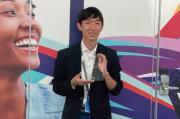 Mikiharu Takeuchi, a doctoral student in the Graduate School of Letters supervised by ARC Deputy Director Prof. Keiji Yano, took home top honors at the award ceremony for the 11th Young Scholar Award sponsored by ESRI, a major geographic information system (GIS) software company based in the United States.
Mikiharu Takeuchi, a doctoral student in the Graduate School of Letters supervised by ARC Deputy Director Prof. Keiji Yano, took home top honors at the award ceremony for the 11th Young Scholar Award sponsored by ESRI, a major geographic information system (GIS) software company based in the United States.
ESRI gives out these awards annually to recognize young researchers from around the world who are conducting outstanding research using GIS. Takeuchi was invited to attend the award ceremony and the 42nd Esri User Conference, both of which were held in San Diego, California on July 13.
Takeuchi has been conducting in-depth research on archaeological heritage management using geospatial information at the Art Research Center and Research Center for Disaster Mitigation of Urban Cultural Heritage. He received this award in recognition of his research in which he used GIS to analyze and disseminate information on the spatial distribution of excavation sites at the Heian-kyo site located in Kyoto City.Comment from Mikiharu Takeuchi (Doctoral student, Graduate School of Letters):
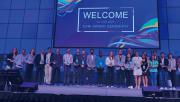 I was honored to receive this prestigious award and be invited to participate in the ESRI End User Conference, which is the largest GIS event in the world. The keynote speeches and corporate exhibits in the huge venue were highly stimulating, as was the chance to meet and interact with award winners and researchers from all over the world.
I was honored to receive this prestigious award and be invited to participate in the ESRI End User Conference, which is the largest GIS event in the world. The keynote speeches and corporate exhibits in the huge venue were highly stimulating, as was the chance to meet and interact with award winners and researchers from all over the world.I would like to express my sincere gratitude to everyone at ESRI Japan for affording me this invaluable experience. I would also like to thank all the people who have helped me along the way, including the professors and students at Tokushima University and Ritsumeikan University, where I studied GIS, and all those who were involved in my research center projects.
[イベント情報]September 30, 2022(Fri)A special feature on the 10th anniversary of the Ritsumeikan Center for Games Studies (RCGS) has been published in Ritsumeikan University's Research Report 'RADIANT', issue #18.
As part of the report, Professor Koichi Hosoi, Deputy Director of the Art Research Center (ARC), gave an interview reflecting on the early days of his game research around 15 years before the RCGS was established, as well as discussing the social impact of games, the acceleration of the metaverse amid COVID-19, and future directions for game research.
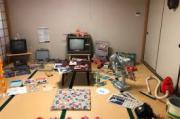
Professor Hosoi took on a pioneering role when he founded the Game Archive Project (GAP)--a collaboration between Kyoto Prefecture, Nintendo, and Ritsumeikan University--at a time when few people at university were interested in games as an industry. The purpose of the GAP was to organize and digital-archive games and game-related materials of the past, and the project paved the way for the establishment of the RCGS.
Furthermore, Professor Hosoi draws on the significant role of the late Professor Masayuki Uemura, the lead architect of Nintendo's Family Computer and Super Nintendo Entertainment System. Professor Uemura, appointed to Ritsumeikan University in 2004, not only served as the first director of the RCGS in 2011 but also led research projects on Japanese traditional performing arts at the ARC, including a digital archive of Noh chants called 'yokyoku' that led to the creation of digital games.
>> Read full article on the RADIANT-website (in Japanese).
Related links:
The ARC Days were held on Sep 16 (Fri) & 17 (Sat), 2022. It is an annual event where the faculty members of the Art Research Center, Ritsumeikan University, and international collaborative researchers whose projects have been adopted by the International Joint Digital Archiving Center for Japanese Art and Culture (ARC-iJAC) introduce their research projects in Digital Humanities (DH) in individual presentations.
To prevent the spread of COVID-19, this event was held online via Zoom and broadcasted live on YouTube.
Organizer: International Joint Digital Archiving Center for Japanese Art and Culture (ARC-iJAC), Art Research Center, Ritsumeikan University and Program for Supporting Research Center Formation, Ritsumeikan University
Read more>>[イベント情報]September 19, 2022(Mon)The Science Council of Japan Kinki District Conference Lecture on 'Learning that fosters Comprehensive Knowledge' will be held under the general chairmanship of Professor Keiji Yano (Faculty of Letters), Deputy Director of the Art Research Center (ARC), Ritsumeikan University.
Date: September 19 (Mon), 2022, 13:00-17:00 JST
Venue: Kyoto University Clock Tower Centennial Hall , Sakyo-ku, Kyoto (online and face-to-face)Anyone is welcome to participate (advance registration required).
Registration deadline: September 14 (Wed), 2022
For the registration and details, please refer to 日本学術会議近畿地区会議学術講演会「総合知をはぐくむ学び」.
On September 6, 2022, the Mainichi Shimbun featured an article on the Kyoto News Archive, a digital archiving project led by Professor Keiji Yano (College of Letters, Ritsumeikan University), Deputy Director of the Art Research Center (ARC).
In collaboration with the Toy Film Museum in Kyoto, Prof. Yano and his team have been building a digital archive of Kyoto News--a series of newsreels produced by Kyoto City between 1956 and 1994 (Showa 31 - Heisei 6).
During that period, the newsreels were shown in movie theaters in Kyoto before the start of the main film. As one of the earliest regional newsreels, they are a valuable historical testimony of Kyoto City. They have recorded a wide range of topics in the city, including seasonal customs and festivals.
[イベント情報]September 1, 2022(Thu)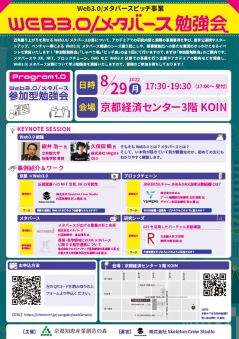 The Art Research Center (ARC) faculty members and deputy directors Professor Koichi Hosoi (College of Image Arts and Sciences, Ritsumeikan University) and Professor Keiji Yano (College of Letters, Ritsumeikan University) participated in the WEB 3.0/Metaverse Study Meeting organized by Kyoto Chiesangyo Sozonomori on August 29, 2022.
The Art Research Center (ARC) faculty members and deputy directors Professor Koichi Hosoi (College of Image Arts and Sciences, Ritsumeikan University) and Professor Keiji Yano (College of Letters, Ritsumeikan University) participated in the WEB 3.0/Metaverse Study Meeting organized by Kyoto Chiesangyo Sozonomori on August 29, 2022.This event provided an opportunity to learn about research in academia and actual business case studies in the Web 3.0/metaverse field, which has been gaining momentum in recent years, to uncover Web 3.0/metaverse-related seeds through industry-academia-government collaboration, start-ups, and ventures, and to trigger new trends towards the creation of new businesses.
Professor Hosoi held a keynote speech on the next-generation internet world as seen through the XR/metaverse. Professor Yano introduced his research with the case study on the construction of Virtual Kyoto using GIS.
The full event video is available below.
[イベント情報]August 26, 2022(Fri)Based on the research cooperation agreement of the Art Research Center (ARC), Ritsumeikan University, with Nara Prefecture, a digital archiving project on Taimadera Temple in Katsuragi, Nara, has been conducted by the ARC faculty member Prof. Tanaka (College of Information Science and Engineering, RU) and his team for the purpose of preserving cultural heritages.
On August 21, 2022, Prof. Tanaka presented the research outcomes of his project on the ultra-high-quality see-through 3D visualization of Taimadera Temple--a national treasure-- at a roundtable event at the Nara Prefecture Historical and Artistic Culture Complex, which was held as part of the special exhibition 'Researching Cultural Heritages' (「文化財研究中!―なら歴史芸術文化村×連携4大学―」). 3D measurements of the entire temple precincts, mainly the Kondou Hall and the West Pagoda, have been taken, with the number of laser-scanned point cloud data exceeding several billion points.
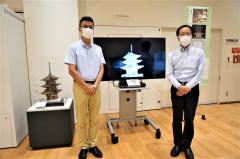
Furthermore, Prof. Tanaka introduced the ARC-iJAC international joint research project on the digital archiving of the Borobudur Temple Compounds in Indonesia--a UNESCO World Heritage Site--to the audience. This project has been conducted in cooperation with the Research Center for Area Studies, National Research and Innovation Agency (PRW-BRIN), Indonesia (previously: Research Center for Area Studies, Indonesian Institute of Sciences (P2W-LIPI)).
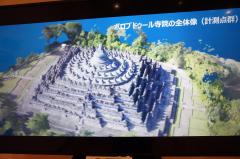
The research outcomes of the ARC, as well as those of three other universities researching various cultural heritages in Nara, are showcased as part of the special exhibition held at the Nara Prefecture Historical and Artistic Culture Complex between July 23 and September 19, 2022.
Related article: An Interview with Prof. Satoshi Tanaka (College of Information Science and Engineering) on Visualizing Large-Scale Cultural Heritage
Related event: Special Exhibition 'Researching Cultural Heritages' at the Nara Prefecture Historical and Artistic Culture Complex
Read more>>[イベント情報]August 25, 2022(Thu) On August 25, 2022, the Art Research Center (ARC), Ritsumeikan University, received the Digital Archive Japan Award (DAJ).
On August 25, 2022, the Art Research Center (ARC), Ritsumeikan University, received the Digital Archive Japan Award (DAJ).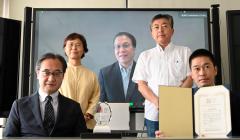 The Digital Archive Japan Award (DAJ) is an award system newly established by Japan Search, an online platform operated by the National Diet Library, Japan, for aggregating metadata of digital resources of various fields, including book/publication, official documents, and art.
The Digital Archive Japan Award (DAJ) is an award system newly established by Japan Search, an online platform operated by the National Diet Library, Japan, for aggregating metadata of digital resources of various fields, including book/publication, official documents, and art.The DAJ Award has been designed to widely introduce to society the initiatives that integrate digital archives into daily life, such as the promotion of digitization, open contents, and the provision of new services using digital technology to create momentum for their utilization. The ARC is honored to be one of the first recipients of this award.
The award ceremony was held at the Digital Archive Fest 2022 (「デジタルアーカイブフェス2022」)--hosted by the National Diet Library and the Cabinet Office--where industry, academia, and government officials gathered to discuss cutting-edge case studies and commended good practices for promoting digital archiving in Japan.
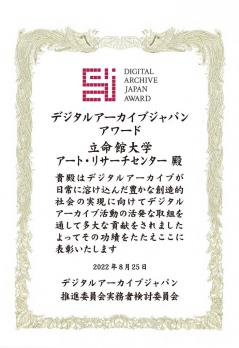
The ARC received this award for its role as an international link for Japanese art and culture by publishing online databases--including ukiyo-e, early Japanese books, and banzuke-related contents--while collaborating with various domestic and international institutions and individuals to enhance the discoverability of such contents and presenting a model in this field of the art and culture. Furthermore, the ARC was recognized for its efforts in developing metadata and providing access to pages that contain terms and conditions of use for each institution.
In his acceptance speech, Professor Ryo Akama, Director of the Art Research Center (ARC), expressed that, for a quarter of a century since its establishment in 1998, the center has been taking digital archives as the foundation for its research activities. On the day, Associate Professor Takaaki Kaneko delivered the award acceptance speech in Prof. Akama's place.
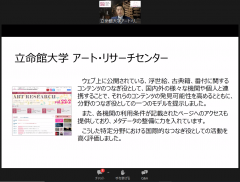
He highlighted that the center has been accumulating a vast amount of contents while mainly targeting overseas museums. "The excellent mechanisms of Japan Search have allowed us to clearly position ourselves as an international link," said Professor Akama.
He expressed his intention to take the Digital Archive Japan Award (DAJ) to provide information on domestic cultural resources and areas other than ukiyo-e, early Japanese books, and banzuke-related contents to further respond to the needs of users worldwide.
Related links:
Japan Search: https://jpsearch.go.jp/
・shiRUto「文系学問の未来を担う「デジタル人文学」(前編) 知られざる価値を見出す仕事」https://shiruto.jp/culture/1799/
・【大学院生の挑戦】空白の江戸中期・天明歌舞伎の実態を解明する~デジタルアーカイブを駆使し、全世界に散らばった浮世絵を統合的に分析~ http://www.ritsumei.ac.jp/news/detail/?id=2694
 12
13
14
15
16
17
18
19
20
21
22
12
13
14
15
16
17
18
19
20
21
22



